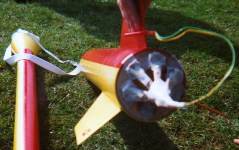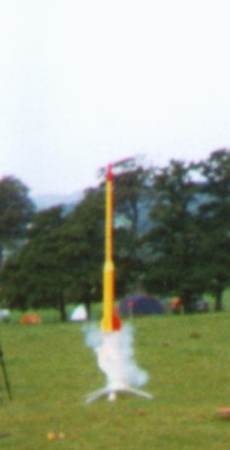Scratch Mark VI Original Design / Scratch Built
Scratch - Mark VI {Scratch}
Contributed by Darren Longhorn
| Manufacturer: | Scratch |
(Contributed - by Darren Longhorn)
 The success of the
MkV made me start to think a bout the bigger tubes I had stacked in the corner.
If I could cluster four engines, why not six? Why not use D engines? I had a
tube that would hold seven 24mm mounts, but it wasn't really long enough. So I
decided to built a rocket reminiscent of the MkIV, with a transition, and
forward fins. With the extra weight of the engines, the plywood fins and
centering rings, this design turned out not to be stable ( Using RockSim). I
increased the length of the upper tube ( forward of the transition) and removed
the forward fins. That was a lot better.
The success of the
MkV made me start to think a bout the bigger tubes I had stacked in the corner.
If I could cluster four engines, why not six? Why not use D engines? I had a
tube that would hold seven 24mm mounts, but it wasn't really long enough. So I
decided to built a rocket reminiscent of the MkIV, with a transition, and
forward fins. With the extra weight of the engines, the plywood fins and
centering rings, this design turned out not to be stable ( Using RockSim). I
increased the length of the upper tube ( forward of the transition) and removed
the forward fins. That was a lot better.
 I had heard of some larger
black powder engines available in the UK form a company called Rocket Services
and wanted to option of installing them. So I went for a removable cartridge
system. The Fins were mounted through the body wall and formed runners onto
which the engine cartridge would slide. The cartridge was made up from two
discs of plywood drilled with holes for the engine mounts. The cartridge slid
in to the body on the runners and was then locked into position by rotating the
whole thing. In the end I just went with six engines. Thrust rings were made
from sawn up spent D engines and epoxied in to place. A stuffer tube was placed
inside the main body, mounted on two centering rings. At ignition the upper
body was to separate, each half with its own parachute. Karen made a red and
white hemispherical 'chute for the lower half, and I was going to use the pink
circular 'chute for the upper half. We intended to fly it at the International
Rocket Weekend, and I had a lot of help from Brain who made and painted the
transition just days before we went.
I had heard of some larger
black powder engines available in the UK form a company called Rocket Services
and wanted to option of installing them. So I went for a removable cartridge
system. The Fins were mounted through the body wall and formed runners onto
which the engine cartridge would slide. The cartridge was made up from two
discs of plywood drilled with holes for the engine mounts. The cartridge slid
in to the body on the runners and was then locked into position by rotating the
whole thing. In the end I just went with six engines. Thrust rings were made
from sawn up spent D engines and epoxied in to place. A stuffer tube was placed
inside the main body, mounted on two centering rings. At ignition the upper
body was to separate, each half with its own parachute. Karen made a red and
white hemispherical 'chute for the lower half, and I was going to use the pink
circular 'chute for the upper half. We intended to fly it at the International
Rocket Weekend, and I had a lot of help from Brain who made and painted the
transition just days before we went.
 At the event, a lot of doubt was raised
about the engine cartridge system. 'Six D ejection charges will blow it out'
they said. I also couldn't determine how I was going to ensure that both
parachutes deployed. In the end I bought some big shock cord and tied both
halves together on the red & white 'chute. Another hitch, I had planned to
add another set of clips to my ignition system, but had forgotten ( that last
week was hectic as I my work had taken me away from home for several days), and
I didn't have a large enough launch pad...
At the event, a lot of doubt was raised
about the engine cartridge system. 'Six D ejection charges will blow it out'
they said. I also couldn't determine how I was going to ensure that both
parachutes deployed. In the end I bought some big shock cord and tied both
halves together on the red & white 'chute. Another hitch, I had planned to
add another set of clips to my ignition system, but had forgotten ( that last
week was hectic as I my work had taken me away from home for several days), and
I didn't have a large enough launch pad...
 Luckily I learned of a new
technique for clustering. This involves using a single igniter to ignite 'quick
match' fuses that are fed into the individual engines. One of the organizers,
John Bonsor, showed me how to do this. I managed to borrow a launcher and after
a wait for the wind to die down, we were ready. The ignition and initial flight
were perfect, except, what was that? A small object appeared to fly from the
back at ejection, and where was the 'chute. The rocket came in ballistically.
What had happened was exactly what the 'doom sayers' were predicting. Even
though I had staggered the ejection by using a mixture of D12 delays, the
ejection gases pushed the engine cartridge out of the rear, instead of
deploying the chute. The rocket was a write off. The engine cartridge
shattered, the forward tube like a concertina, and the aft tube a slowly
unwinding spiral.
Luckily I learned of a new
technique for clustering. This involves using a single igniter to ignite 'quick
match' fuses that are fed into the individual engines. One of the organizers,
John Bonsor, showed me how to do this. I managed to borrow a launcher and after
a wait for the wind to die down, we were ready. The ignition and initial flight
were perfect, except, what was that? A small object appeared to fly from the
back at ejection, and where was the 'chute. The rocket came in ballistically.
What had happened was exactly what the 'doom sayers' were predicting. Even
though I had staggered the ejection by using a mixture of D12 delays, the
ejection gases pushed the engine cartridge out of the rear, instead of
deploying the chute. The rocket was a write off. The engine cartridge
shattered, the forward tube like a concertina, and the aft tube a slowly
unwinding spiral.
The pic of lift off was the last shout from my last roll of film, so mercifully there are no pictures of the rocket as we found it. The realization of the hours we had all spent on this rocket, which was now trash, didn't sink in until later, and it was a long drive home from Largs to Leeds.
Sponsored Ads
 |
 |











